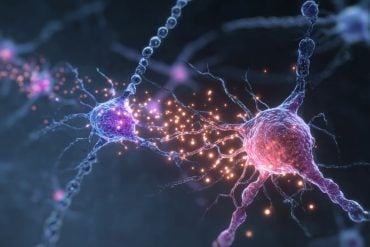Summary: Researchers have developed a new prosthetic arm that stimulates the nerves in the amputated limb, allowing the patient to feel the sense of touch.
Source: University of Illinois.
Losing an arm doesn’t have to mean losing all sense of touch, thanks to prosthetic arms that stimulate nerves with mild electrical feedback.
University of Illinois researchers have developed a control algorithm that regulates the current so a prosthetics user feels steady sensation, even when the electrodes begin to peel off or when sweat builds up.
“We’re giving sensation back to someone who’s lost their hand. The idea is that we no longer want the prosthetic hand to feel like a tool, we want it to feel like an extension of the body,” said Aadeel Akhtar, an M.D./Ph.D. student in the neuroscience program and the medical scholars program at the University of Illinois. Akhtar is the lead author of a paper describing the sensory control module, published in Science Robotics, and the founder and CEO of PSYONIC, a startup company that develops low-cost bionic arms.
“Commercial prosthetics don’t have good sensory feedback. This is a step toward getting reliable sensory feedback to users of prosthetics,” he said.
Prosthetic arms that offer nerve stimulation have sensors in the fingertips, so that when the user comes in contact with something, an electrical signal on the skin corresponds to the amount of pressure the arm exerts. For example, a light touch would generate a light sensation, but a hard push would have a stronger signal.
However, there have been many problems with giving users reliable feedback, said aerospace engineering professor Timothy Bretl, the principal investigator of the study. During ordinary wear over time, the electrodes connected to the skin can begin to peel off, causing a buildup of electrical current on the area that remains attached, which can give the user painful shocks. Alternately, sweat can impede the connection between the electrode and the skin, so that the user feels less or even no feedback at all.
“A steady, reliable sensory experience could significantly improve a prosthetic user’s quality of life,” Bretl said.
The controller monitors the feedback the patient is experiencing and automatically adjusts the current level so that the user feels steady feedback, even when sweating or when the electrodes are 75 percent peeled off.
The researchers tested the controller on two patient volunteers. They performed a test where the electrodes were progressively peeled back and found that the control module reduced the electrical current so that the users reported steady feedback without shocks. They also had the patients perform a series of everyday tasks that could cause loss of sensation due to sweat: climbing stairs, hammering a nail into a board and running on an elliptical machine.
“What we found is that when we didn’t use our controller, the users couldn’t feel the sensation anymore by the end of the activity. However, when we had the control algorithm on, after the activity they said they could still feel the sensation just fine,” Akhtar said.

Adding the controlled stimulation module would cost much less than the prosthetic itself, Akhtar said. “Although we don’t know yet the exact breakdown of costs, our goal is to have it be completely covered by insurance at no out-of-pocket costs to users.”
The group is working on miniaturizing the module that provides the electrical feedback, so that it fits inside a prosthetic arm rather than attaching to the outside. They also plan to do more extensive patient testing with a larger group of participants.
“Once we get a miniaturized stimulator, we plan on doing more patient testing where they can take it home for an extended period of time and we can evaluate how it feels as they perform activities of daily living. We want our users to be able to reliably feel and hold things as delicate as a child’s hand,” Akhtar said. “This is a step toward making a prosthetic hand that becomes an extension of the body rather than just being another tool.”
Funding: The National Institutes of Health and the National Science Foundation supported this work.
Source: University of Illinois
Publisher: Organized by NeuroscienceNews.com.
Image Source: NeuroscienceNews.com image is credited to Aadeel Akhtar.
Original Research: Abstract for “Controlling sensation intensity for electrotactile stimulation in human-machine interfaces” by Aadeel Akhtar, Joseph Sombeck, Brandon Boyce and Timothy Bretl in Science Robotics. Published April 24 2018.
doi:10.1126/scirobotics.aap9770
[cbtabs][cbtab title=”MLA”]University of Illinois “Prosthetic Arms Can Provide Controlled Sensory Feedback.” NeuroscienceNews. NeuroscienceNews, 28 April 2018.
<https://neurosciencenews.com/sensory-feedback-prosthetics-8907/>.[/cbtab][cbtab title=”APA”]University of Illinois (2018, April 28). Prosthetic Arms Can Provide Controlled Sensory Feedback. NeuroscienceNews. Retrieved April 28, 2018 from https://neurosciencenews.com/sensory-feedback-prosthetics-8907/[/cbtab][cbtab title=”Chicago”]University of Illinois “Prosthetic Arms Can Provide Controlled Sensory Feedback.” https://neurosciencenews.com/sensory-feedback-prosthetics-8907/ (accessed April 28, 2018).[/cbtab][/cbtabs]
Abstract
Controlling sensation intensity for electrotactile stimulation in human-machine interfaces
A barrier to practical use of electrotactile stimulation for haptic feedback has been large variability in perceived sensation intensity because of changes in the impedance of the electrode-skin interface, such as when electrodes peel or users sweat. We show how to significantly reduce this variability by modulating stimulation parameters in response to measurements of impedance. Our method derives from three contributions. First, we created a model between stimulation parameters and impedance at constant perceived sensation intensity by looking at the peak pulse energy and phase charge. Our model fits experimental data better than previous models [mean correlation coefficient (r2) > 0.9] and holds over a larger set of conditions (participants, sessions, magnitudes of sensation, stimulation locations, and electrode sizes). Second, we implemented a controller that regulates perceived sensation intensity by using our model to derive a new current amplitude and pulse duration in response to changes in impedance. Our controller accurately predicts participant-chosen stimulation parameters at constant sensation intensity (mean r2 > 0.9). Third, we demonstrated as a proof of concept on two participants with below-elbow amputations—using a prosthesis with electrotactile touch feedback—that our controller can regulate sensation intensity in response to large impedance changes that occur in activities of daily living. These results make electrotactile stimulation for human-machine interfaces more reliable during activities of daily living.






